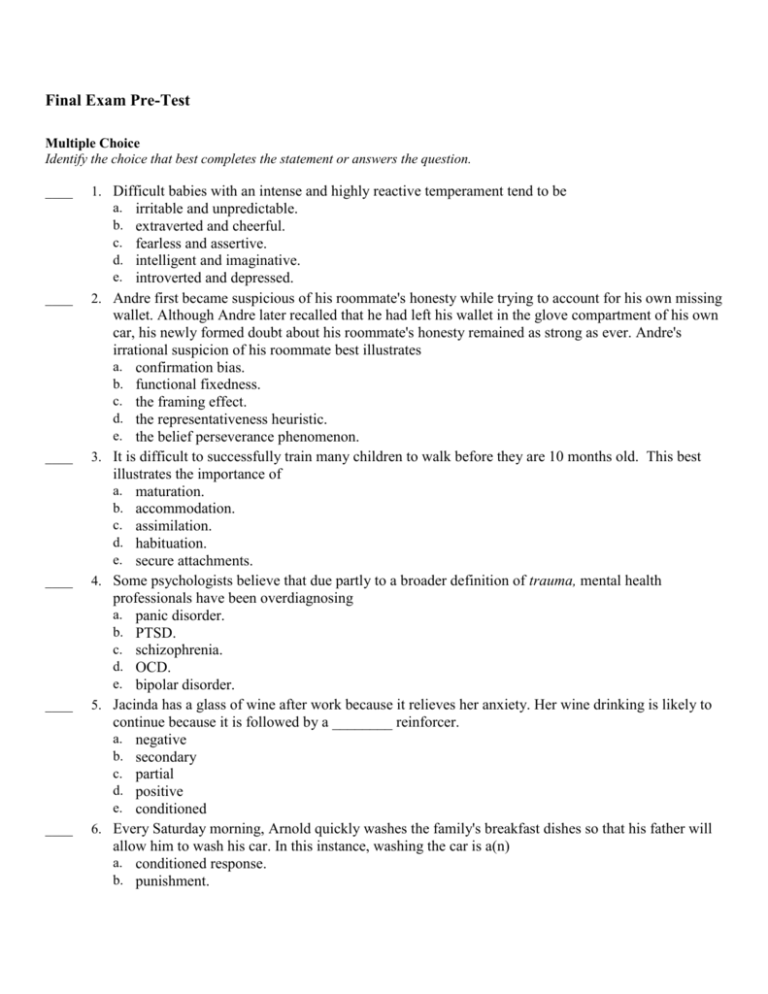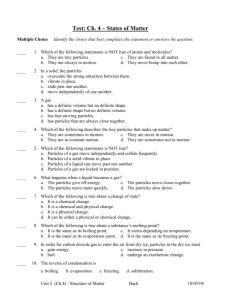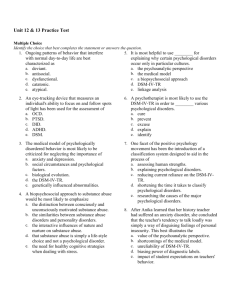Final Exam Pre-Test - Public Schools of Robeson County
advertisement

Final Exam Pre-Test Multiple Choice Identify the choice that best completes the statement or answers the question. ____ 1. Difficult babies with an intense and highly reactive temperament tend to be a. irritable and unpredictable. b. extraverted and cheerful. c. fearless and assertive. d. intelligent and imaginative. e. introverted and depressed. ____ 2. Andre first became suspicious of his roommate's honesty while trying to account for his own missing ____ 3. ____ 4. ____ 5. ____ 6. wallet. Although Andre later recalled that he had left his wallet in the glove compartment of his own car, his newly formed doubt about his roommate's honesty remained as strong as ever. Andre's irrational suspicion of his roommate best illustrates a. confirmation bias. b. functional fixedness. c. the framing effect. d. the representativeness heuristic. e. the belief perseverance phenomenon. It is difficult to successfully train many children to walk before they are 10 months old. This best illustrates the importance of a. maturation. b. accommodation. c. assimilation. d. habituation. e. secure attachments. Some psychologists believe that due partly to a broader definition of trauma, mental health professionals have been overdiagnosing a. panic disorder. b. PTSD. c. schizophrenia. d. OCD. e. bipolar disorder. Jacinda has a glass of wine after work because it relieves her anxiety. Her wine drinking is likely to continue because it is followed by a ________ reinforcer. a. negative b. secondary c. partial d. positive e. conditioned Every Saturday morning, Arnold quickly washes the family's breakfast dishes so that his father will allow him to wash his car. In this instance, washing the car is a(n) a. conditioned response. b. punishment. c. negative reinforcer. d. positive reinforcer. e. unconditioned response. ____ 7. For a fraction of a second after the lightning flash disappeared, Ileana retained a vivid mental image ____ 8. ____ 9. ____ 10. ____ 11. ____ 12. of its ragged edges. Her experience most clearly illustrates the nature of _______ memory. a. iconic b. flashbulb c. recall d. implicit e. explicit Some people are better than others at detecting slight variations in the tastes of various blends of coffee. This best illustrates the importance of a. sensory adaptation. b. subliminal stimulation. c. parallel processing. d. difference thresholds. e. the vestibular sense. Kammy vividly imagines being abused by her own mother while her therapist triggers eye movements by waving a finger in front of Kammy's eyes. The therapist is apparently using a technique known as a. transference. b. systematic desensitization. c. virtual reality exposure therapy. d. EMDR. e. meta-analysis. At the age of 22, Mrs. LaBlanc was less than 4 feet tall. Her short stature was probably influenced by the lack of a growth hormone produced by the a. myelin. b. thyroid. c. adrenal gland. d. pituitary gland. e. pancreas. Judson is a 70-year-old retired automobile mechanic. In contrast to when he was 20, he now probably a. experiences less life satisfaction. b. has a greater fear of death. c. is less susceptible to catching colds. d. would not do as well on a vocabulary test. e. has increased fluid intelligence. Naseeb disagrees with his classmates on an issue. During a class discussion of the issue, Naseeb is MOST likely to conform to his classmates' opinion if he a. has a high level of self-esteem. b. does not have to reveal his personal opinion at the close of the class discussion. c. never developed a strong attachment to his mother. d. verbally expresses his own unique opinion early in the class discussion. e. believes the rest of the class is unanimous in their position. ____ 13. The misinformation effect refers to the a. the eerie sense that “I've been in this exact situation before. ” b. tendency to recall experiences that are consistent with one's current good or bad mood. c. incorporation of misleading information into one's memory of an event. d. negative effect of incorrect information on recall. e. disruptive effect of prior learning on the recall of new information. ____ 14. To understand the unusual behavior of an adult client, a clinical psychologist carefully investigates ____ 15. ____ 16. ____ 17. ____ 18. the client's current life situation and his physical, social-cultural, and educational history. Which research method has the psychologist used? a. correlation b. experimentation c. naturalistic observation d. the survey e. the case study The home environment most clearly has a greater influence on children's ________ than on their ________. a. extraversion; table manners b. shyness; social group c. DNA; genes d. personality; political attitudes e. religious beliefs; personality traits Despite overwhelming and highly publicized evidence that Senator McEwan was guilty of serious political corruption and misconduct, many who had supported her in past elections remained convinced of her political integrity. Their reaction best illustrates a. belief perseverance. b. functional fixedness. c. the availability heuristic. d. the representativeness heuristic. e. the framing effect. After repeatedly taking alcohol spiked with a nausea-producing drug, people with alcohol dependence may fail to develop an aversive reaction to alcohol because they blame their nausea on the drug. This illustrates the importance of ________ in classical conditioning. a. spontaneous recovery b. negative reinforcement c. generalization d. cognitive processes e. biological predispositions Dr. Ensing studies the reactions of very young children who are briefly separated from their mothers while in an unfamiliar setting. It is most likely that Dr. Ensing is conducting research on a. habituation. b. the rooting reflex. c. attachment. d. egocentrism. e. conservation. ____ 19. Infant novelty preferences have been discovered by assessing infants' a. imprinting. b. accommodation. c. reflexes. d. conservation. e. habituation. ____ 20. Which theory can best explain why people respond differently to the same stimuli? a. signal detection theory b. frequency theory c. the Young-Helmholtz theory d. opponent-process theory e. bottom-up theory ____ 21. After prolonged exposure to television violence, viewers became more indifferent to violence when later viewing a brawl, whether on TV or in real life. This finding best illustrates a. spontaneous recovery. b. instinctive drift. c. latent learning. d. extinction. e. desensitization. ____ 22. We compute motion based on the assumption that shrinking objects are a. schemas. b. retreating. c. binocular cues. d. transduced. e. fixation points. ____ 23. How do evolutionary psychologists explain why pregnant women from cultures across the world tend to avoid bitter, strongly flavored foods? a. Historical preferences toward or against certain tastes tend to change as cultures change. b. Women and men have genetic differences in taste preferences. c. Bitter tastes can be an indication of foods toxic toward a developing baby, so this preference developed through natural selection. d. Most cultures educate women about the dangers of certain foods on a developing fetus. e. Pregnant women tend to associate with one another and they acquire similar food preferences through social conformity. ____ 24. Imagine that a softball player wears special glasses that shift her visual field upward 20 degrees. This means that when the player wears these glasses, everything appears higher than it actually is. With practice the player can hit a ball with the glasses on. What will happen when the player first hits a ball with the glasses off? a. She will accurately perceive where the ball really is. b. She will believe that the ball is lower than it really is. c. She will use the context of the situation to determine where the ball is. d. She will easily hit the ball because of visual accommodation to the changing stimuli. e. She will believe that the ball is higher than it really is. ____ 25. Because Ken is 6’4”, people often mistakenly assume that he must be a member of his high school ____ 26. ____ 27. ____ 28. ____ 29. ____ 30. ____ 31. basketball team. This mistaken judgment best illustrates the impact of a. the belief perseverance phenomenon. b. the availability heuristic. c. the representativeness heuristic. d. framing. e. confirmation bias. Stage theories of adult development are most likely to be criticized for exaggerating the a. importance of fluid intelligence. b. importance of social influence. c. interaction of nature and nurture. d. stability of personality. e. predictability of development. According to social exchange theory, altruistic behavior is guided by a. feelings of social responsibility. b. family ties. c. calculations of costs and benefits. d. reciprocity norms. e. self-esteem. Deaf people who use sign language typically a. recognize facial expressions of emotion with their left rather than their right cerebral hemisphere. b. have a smaller corpus callosum than hearing persons. c. process language in their left cerebral hemisphere. d. process language in the right hemisphere rather than the left. e. demonstrate greater mathematical competence than hearing persons. Group therapy is typically more effective than individual therapy for a. eliminating clients' anxiety during the process of therapy. b. encouraging severely disturbed individuals to quickly regain normal social functioning. c. enabling people to discover that others have problems similar to their own. d. enhancing the resilience of people with anxiety disorders. e. ensuring that therapists will become more emotionally involved in clients' real-life problems. The ratio of males to females first begins declining during a. adulthood. b. infancy. c. prenatal development. d. adolescence. e. childhood. The representativeness heuristic refers to our tendency to a. judge the likelihood of category membership by how closely an object or event resembles a particular prototype. b. c. d. e. ____ 32. ____ 33. ____ 34. ____ 35. ____ 36. ____ 37. cling to our initial conceptions, even though they have been discredited. underestimate the accuracy of our beliefs and judgments. search for information that is consistent with our preconceptions. judge the likelihood of an event in terms of how readily instances of its occurrence are remembered. The belief that boys are more independent than girls is a a. gender type. b. gender schema. c. gender assimilation. d. gender role. e. gender identity. Which of the following best illustrates overgeneralization in a young child's speech pattern? a. “Da-da, na-na, ta-ta. ” b. “Want juice. ” c. “Fish, Fish! Look at the fish!” d. “Doggy big.” e. “Momma holded the baby.” People's physical attractiveness is unrelated to their a. frequency of dating. b. perceived friendliness. c. level of earned income. d. feelings of popularity. e. self-esteem. Because she believes that boys are naughtier than girls, Mrs. Zumpano, a second-grade teacher, watches boys more closely than she watches girls for any signs of misbehavior. Mrs. Zumpano's surveillance strategy best illustrates a. confirmation bias. b. the representativeness heuristic. c. the framing effect. d. the availability heuristic. e. functional fixedness. Which perspective suggests that depression is a reaction to loss and the internalization of unresolved anger toward parents? a. social-cognitive b. humanistic c. psychoanalytic d. learning e. biological Who emphasized that perceptual understanding comes from inborn ways of organizing sensory experience? a. John Locke b. Sigmund Freud c. Aristotle d. B. F. Skinner e. Immanuel Kant ____ 38. What is the purpose of the eardrum? a. Transduction of sound waves into neural messages occurs in the eardrum. b. Movement of the eardrum directly causes the stirrup to vibrate. c. Axons on the eardrum converge to form the auditory nerve, which sends auditory messages to the brain. d. Vibration of the eardrum directly causes ripples in the basilar membrane. e. To transmit sound from the air to the bones of the middle ear. ____ 39. The most foolproof way of testing the true effectiveness of a newly introduced method of psychological therapy is by means of a. naturalistic observation. b. case study research. c. experimental research. d. correlational research. e. survey research. ____ 40. When 12-year-old Jamilah saw an old man lying on the sidewalk in apparent discomfort, he prepared to offer help. But when he noticed several adults walk past the man, he concluded that the man did not need any help. His reaction most clearly illustrates one of the dynamics involved in a. the bystander effect. b. the mere exposure effect. c. the foot-in-the-door phenomenon. d. the fundamental attribution error. e. social loafing. Final Exam Pre-Test Answer Section MULTIPLE CHOICE 1. ANS: REF: TOP: 2. ANS: REF: OBJ: MSC: 3. ANS: REF: TOP: 4. ANS: REF: TOP: 5. ANS: OBJ: 6. ANS: OBJ: 7. ANS: REF: TOP: 8. ANS: REF: TOP: 9. ANS: REF: OBJ: MSC: 10. ANS: REF: OBJ: 11. ANS: REF: TOP: 12. ANS: REF: TOP: 13. ANS: REF: TOP: 14. ANS: REF: OBJ: 15. ANS: A PTS: 1 DIF: Difficult Page 428 | Section- Developmental Psychology OBJ: 6 Attachment differences: temperament and parenting MSC: Factual | Definitional E PTS: 1 DIF: Difficult Page 307 | Section- Cognition: 7B—Thinking-Problem Solving-Creativity-and Language 5 TOP: The belief perseverance phenomenon Conceptual | Application A PTS: 1 DIF: Medium Page 416 | Section- Developmental Psychology OBJ: 3 Motor development MSC: Conceptual B PTS: 1 DIF: Easy Page 573 | Section- Abnormal Psychology OBJ: 7 Post-traumatic stress disorder MSC: Factual | Definitional A PTS: 1 DIF: Difficult REF: Page 231 | Section- Learning 8 TOP: MSCs of reinforcers MSC: Conceptual | Application D PTS: 1 DIF: Difficult REF: Page 231 | Section- Learning 8 TOP: MSCs of reinforcers MSC: Conceptual | Application A PTS: 1 DIF: Medium Page 266 | Section- Cognition: 7A—Memory OBJ: 4 Sensory memory MSC: Conceptual | Application D PTS: 1 DIF: Easy Page 122 | Section- Sensation and Perception OBJ: 3 Difference thresholds MSC: Conceptual | Application D PTS: 1 DIF: Medium Page 624 | Section- Treatment of Psychological Disorders 11 TOP: Eye movement desensitization and reprocessing Conceptual | Application D PTS: 1 DIF: Difficult Page 63 | Section- Biological Bases of Behavior: 3A—Neural Processing and the Endocrine System 6 TOP: The endocrine system MSC: Conceptual | Application C PTS: 1 DIF: Difficult Page 459 | Section- Developmental Psychology OBJ: 20 Physical changes in later life MSC: Conceptual | Application E PTS: 1 DIF: Difficult Page 652 | Section- Social Psychology OBJ: 3 Conditions that strengthen conformity MSC: Conceptual | Application C PTS: 1 DIF: Easy Page 286 | Section- Cognition: 7A—Memory OBJ: 11 Misinformation and imagination effects MSC: Factual | Definitional E PTS: 1 DIF: Medium Page 26 | Section- Research Methods: Thinking Critically With Psychological Science 4 TOP: The case study MSC: Conceptual | Application E PTS: 1 DIF: Medium 16. 17. 18. 19. 20. 21. 22. 23. 24. 25. 26. 27. 28. 29. 30. REF: Page 99 | Section- Biological Bases of Behavior: 3C—Genetics-Evolutionary Psychology-and Behavior OBJ: 2 TOP: Biological versus adoptive relatives MSC: Factual | Definitional ANS: A PTS: 1 DIF: Medium REF: Page 307 | Section- Cognition: 7B—Thinking-Problem Solving-Creativity-and Language OBJ: 5 TOP: The belief perseverance phenomenon MSC: Conceptual | Application ANS: D PTS: 1 DIF: Medium REF: Page 223 | Section- Learning OBJ: 4 TOP: Extending Pavlov's understanding: cognitive processes MSC: Factual | Definitional ANS: C PTS: 1 DIF: Easy REF: Page 428 | Section- Developmental Psychology OBJ: 6 TOP: Attachment differences: temperament and parenting MSC: Conceptual | Application ANS: E PTS: 1 DIF: Difficult REF: Page 414 | Section- Developmental Psychology OBJ: 2 TOP: The competent newborn MSC: Factual | Definitional ANS: A PTS: 1 DIF: Easy REF: Page 121 | Section- Sensation and Perception OBJ: 3 TOP: Signal detection MSC: Factual | Definitional ANS: E PTS: 1 DIF: Medium REF: Page 249 | Section- Learning OBJ: 14 TOP: Antisocial effects MSC: Factual | Definitional ANS: B PTS: 1 DIF: Easy REF: Page 156 | Section- Sensation and Perception OBJ: 17 TOP: Motion perception MSC: Factual | Definitional ANS: C PTS: 1 DIF: Medium REF: Page 104 | Section- Biological Bases of Behavior: 3C—Genetics-Evolutionary Psychology-and Behavior OBJ: 5 TOP: Evolutionary success helps explain similarities MSC: Factual | Definitional ANS: B PTS: 1 DIF: Medium REF: Page 160 | Section- Sensation and Perception OBJ: 19 TOP: Perceptual adaptation MSC: Conceptual | Application ANS: C PTS: 1 DIF: Difficult REF: Page 304 | Section- Cognition: 7B—Thinking-Problem Solving-Creativity-and Language OBJ: 4 TOP: The representativeness heuristic MSC: Conceptual | Application ANS: E PTS: 1 DIF: Difficult REF: Page 472 | Section- Developmental Psychology OBJ: 24 TOP: Continuity and stages MSC: Factual | Definitional ANS: C PTS: 1 DIF: Medium REF: Page 687 | Section- Social Psychology OBJ: 17 TOP: The norms for helping MSC: Factual | Definitional ANS: C PTS: 1 DIF: Medium REF: Page 87 | Section- Biological Bases of Behavior: 3B—The Brain OBJ: 9 TOP: Right-left differences in the intact brain MSC: Factual | Definitional ANS: C PTS: 1 DIF: Easy REF: Page 617 | Section- Treatment of Psychological Disorders OBJ: 8 TOP: Group and family therapies MSC: Factual | Definitional ANS: A PTS: 1 DIF: Medium REF: Page 455 | Section- Developmental Psychology OBJ: 20 TOP: 31. ANS: REF: OBJ: 32. ANS: REF: TOP: 33. ANS: REF: OBJ: 34. ANS: REF: TOP: 35. ANS: REF: OBJ: 36. ANS: REF: TOP: 37. ANS: REF: TOP: 38. ANS: REF: TOP: 39. ANS: REF: OBJ: 40. ANS: REF: TOP: Physical changes in later life MSC: Factual | Definitional A PTS: 1 DIF: Medium Page 304 | Section- Cognition: 7B—Thinking-Problem Solving-Creativity-and Language 4 TOP: The representativeness heuristic MSC: Factual | Definitional B PTS: 1 DIF: Difficult Page 440 | Section- Developmental Psychology OBJ: 13 Gender and child-rearing MSC: Conceptual E PTS: 1 DIF: Medium Page 317 | Section- Cognition: 7B—Thinking-Problem Solving-Creativity-and Language 8 TOP: Explaining language development MSC: Conceptual | Application E PTS: 1 DIF: Medium Page 680 | Section- Social Psychology OBJ: 14 The psychology of attraction: physical attractiveness MSC: Factual | Definitional A PTS: 1 DIF: Medium Page 303 | Section- Cognition: 7B—Thinking-Problem Solving-Creativity-and Language 3 TOP: Confirmation bias MSC: Conceptual | Application C PTS: 1 DIF: Medium Page 583 | Section- Abnormal Psychology OBJ: 13 Understanding mood disorders MSC: Factual | Definitional E PTS: 1 DIF: Medium Page 159 | Section- Sensation and Perception OBJ: 19 Perceptual interpretation MSC: Factual | Definitional E PTS: 1 DIF: Easy Page 135 | Section- Sensation and Perception OBJ: 8 The ear MSC: Factual | Definitional C PTS: 1 DIF: Easy Page 34 | Section- Research Methods: Thinking Critically With Psychological Science 7 TOP: Experimentation MSC: Factual | Definitional A PTS: 1 DIF: Easy Page 686 | Section- Social Psychology OBJ: 16 Bystander intervention MSC: Conceptual | Application









